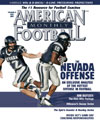AMERICAN FOOTBALL MONTHLY THE #1 RESOURCE FOR FOOTBALL COACHES
Article CategoriesAFM Magazine
|
6 Keys to Effective Defensive Communication: From the Sideline to the Fieldby: AFM Editorial Staff© More from this issue In five years as either the defensive coordinator or head coach at Olathe North High School in Kansas, John McCall’s teams won four state championships. In the other year they were runner-up, meaning that for five straight seasons Olathe North was in the state title game. The past three seasons McCall has served as DC under head coach Gene Weir at Richland High School in North Richland Hills, TX. McCall believes effective communication is the key to a successful defense. “Breakdowns in communication directly cause breakdowns in your defense,” according to McCall. “A mistake in the communication process starts a chain reaction that usually is negative for a defense. First, the defense will not align properly. Second, bad alignment may cause the players to read the wrong key. Now pressure and coverage will not be coordinat....The full article can only be seen by subscribers. Subscribe today!
|
|
|||||||
| HOME |
MAGAZINE |
SUBSCRIBE | ONLINE COLUMNISTS | COACHING VIDEOS |
Copyright 2025, AmericanFootballMonthly.com
All Rights Reserved





